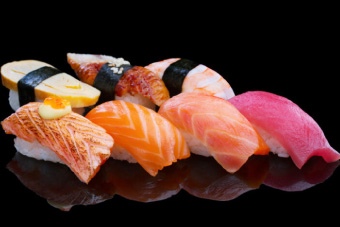You do everything you can to grow and nourish a healthy baby when pregnant. Of course, eating a healthy pregnancy diet is a foundational step in that process. So, it can be alarming when you learn that one of the most beneficial proteins on the pregnancy diet list (fish) may also be one of the most toxic.
Minimize Mercury Exposure from Seafood When You’re Pregnant
 Unfortunately, widespread pollution of the ocean means many seafood options are contaminated. Contamination levels vary according to geography and which type of fish or shellfish are caught. However, mercury is one of the most common toxic metals found in seafood, and it poses a significant risk to you and your baby.
Unfortunately, widespread pollution of the ocean means many seafood options are contaminated. Contamination levels vary according to geography and which type of fish or shellfish are caught. However, mercury is one of the most common toxic metals found in seafood, and it poses a significant risk to you and your baby.
According to the March of Dimes, higher-than-safe levels of mercury can damage your baby’s lungs, kidneys, and nervous system – including the brain and spinal cord.
However, the health benefits of the right fish far outweigh the risks.
You can do several things to enjoy healthy seafood options while minimizing the amount of mercury you ingest.
1. Don’t overdo it on fish consumption
Yes, fish is one of the healthiest sources of protein, omega-3s, and minerals. However, there’s no need to overdo it. The FDA recommends pregnant women eat between 8 and 12 ounces of fish per week. This is the equivalent of one or two moderately-portioned fish filets or a smaller fillet and a tuna or salmon salad/sandwich.
And, of course, don’t forget that sushi and any raw or undercooked fish is one of the big no-nos while pregnant!
2. Only consume safe fish
Some fish and seafood products are safer than others. Only consume cooked fish that is safe to eat while pregnant. The fish considered the healthiest to eat while pregnant are:
We use the acronym S.M.A.S.H. for these fish, making it easier to remember which ones are safe.
- Salmon
- Mackerel (Atlantic or Norwegian; not King or Spanish)
- Anchovies
- Sardines
- Herring
The following fish are more likely to have mercury, but less of it. These fish are considered “safe” as long as you only consume no more than three, 6 ounce portions per month:
- Sea Bass
- Croaker
- Halibut Bluefish
- Tuna (canned, white albacore)
- Tuna (fresh bluefin, ahi). Remember, no raw fish. For example, “seared” ahi still contains a raw center, so these tuna options must be cooked completely.
- Sea Trout
- Lobster (American, Maine)
3. Be careful about the tuna you buy
Tuna salads and sandwiches are delicious and healthy – but not all tuna is considered safe. Notice it’s not on the SMASH list? That’s because some tuna have notoriously high mercury levels. If you enjoy tuna, opt for canned, light tuna – and limit white, albacore tuna consumption to no more than 6 ounces per week (and factor that into your 8 to 12-ounce weekly limit).
There is no doubt that you get what you pay for with tuna. So, if you can afford it, seek out higher-end labels, like Safe Catch, that are conscientious about how they fish, working conditions for employees, and test their product’s mercury levels.
4. Avoid fish notoriously high in mercury
In truth, everyone should scratch certain fish off their list due to notoriously high mercury exposure. However, you should absolutely avoid them when they’re pregnant.
Fish most likely to have worry-worthy mercury levels are:
- Grouper
- Marlin
- Orange roughy
- Tilefish
- Swordfish
- Shark
- King or Spanish Mackerel (again, these are different from Alaskan or Norwegian mackerel options, which are on the safe list as their waters are cleaner).
If these fish are some of your favorites, we get it. But it’s much healthier for you and your baby if you avoid them for now and while breastfeeding.
Other Ways to Minimize Mercury Exposure
While eating fish provides a direct line to mercury exposure, be careful when it comes to other everyday mercury exposure potential:
- Ask your dentist for alternative, mercury-free options if you need to get a filling. Also, avoid having mercury fillings removed unless they’re broken or damaged. Don’t forget that going to the dentist is essential for pregnancy health.
- Ask an adult who’s not pregnant to throw away any broken thermometers or fluorescent light bulbs. Store these items in a way that prevents them from breaking, and don’t let children use them. Never use a vacuum cleaner to clean spilled mercury. Here are instructions on how to safely clean up spilled mercury.
- If your work exposes you to mercury, speak to your managers about how to provide extra layers of safety to protect you from harmful contamination. It may even be worth changing positions (if possible) until after your baby is born.
WHA is Here to Guide Your Pregnancy Diet Choices
Don’t hesitate to call Women’s Health Associates if you have questions about what’s safe – or not – while you’re pregnant. We see first-hand how the right pregnancy diet supports healthy, full-term pregnancies. Want to check in with us about what you can eat and what to avoid? Schedule a prenatal appointment with us.
